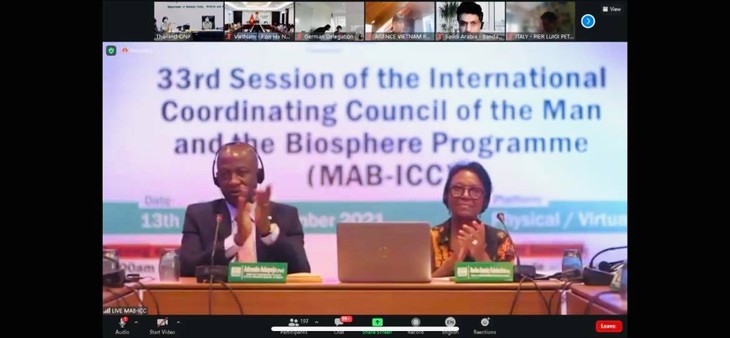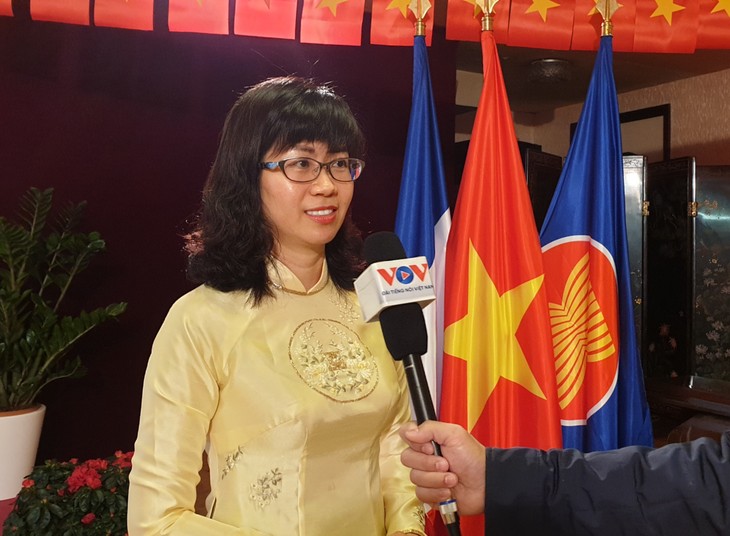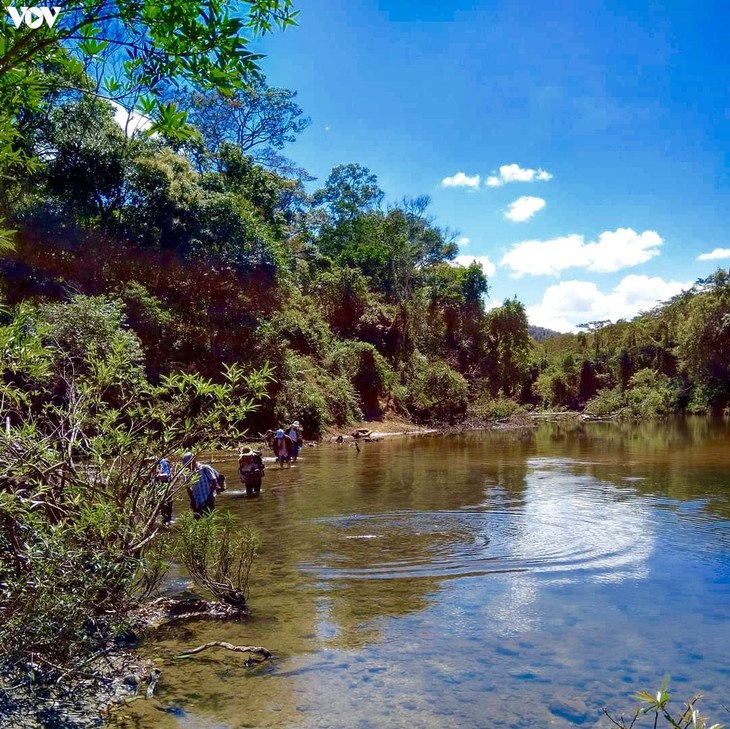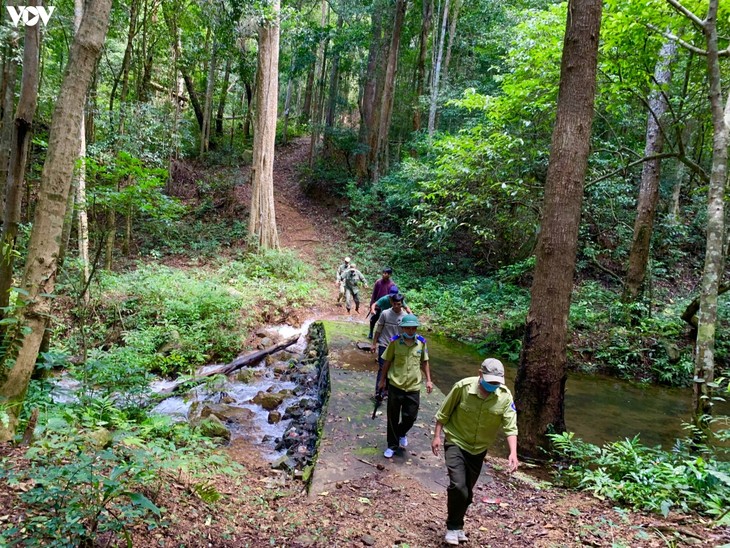 Nui Chua and Kon Ha Nung are added to the World Network of Biosphere Reserves at the 33 session of the International Coordinating Council of the Man and the Biosphere Program in September 2021. (Photo: Quang Dung/VOV Paris) Nui Chua and Kon Ha Nung are added to the World Network of Biosphere Reserves at the 33 session of the International Coordinating Council of the Man and the Biosphere Program in September 2021. (Photo: Quang Dung/VOV Paris) |
Among 22 nominees from 20 countries, UNESCO recognized two dossiers from Vietnam, taking the number of global biosphere reserves in Vietnam to 11, one of the highest in the world. In Southeast Asia, it is second only to Indonesia with 19 sites.
Situated at a height of 1,000 meters above sea level, Nui Chua National Park is seen as the green lung of the central Ninh Thuan Province. It has over 20,000 ha of primeval forests and is home to 300 animal species and 600 plant species.
Kon Ha Nung Plateau is located in the Central Highlands province of Gia Lai, covering a total area of more than 400,000 ha. It includes two zones of Kon Ka Kinh National Park and Kon Chu Rang Nature Reserve, which are home to hundreds of animal and plant species, including rare ones like the gray-shanked douc langur.
Ambassador and Head of the Vietnamese delegation to UNESCO Le Thi Hong Van said the sites meet 7 criteria set by the International Coordinating Council of UNESCO's Man and the Biosphere Program.
 Ambassador and Head of the Vietnamese delegation to UNESCO Le Thi Hong Van. Ambassador and Head of the Vietnamese delegation to UNESCO Le Thi Hong Van. |
“Nui Chua National Park is a place where three natural areas of forest, sea and semi-desert converge, creating rich and diverse ecosystems which are the habitats of various kinds of rare and endemic animals and plants on land and in the sea,” said Ambassador Van.
”The Kon Ha Nung Plateau features special character of the Central Highlands and the biodiversity of a closed subtropical evergreen forest ecosystem. Both natural reserves have typical characteristics of the local residents. Considering the criteria, our two applications were approved by the International Coordinating Council in the first stage,” she said.
The Man and the Biosphere Program has been the oldest program of the UNESCO to promote educational, research, and awareness-raising work to foster innovative sustainable development practices and combat the loss of biodiversity.
The network supports local and indigenous communities and Member States’ understanding, and the protection of the natural environment.
It also advocates for localities, information and knowledge sharing on biodiversity protection, climate change response in combination with sustainable development.
Global biosphere reserves – not only a title
Ambassador Van said it is an international recognition of the diversity and development of natural and biological values and cultural values of the communities as well as the efforts of local people in conserving sustainable biodiversity.
“UNESCO's registration of our two biosphere reserves is not just a title but really opens up many opportunities for us to learn from experiences, promote initiatives in environmental protection, conserve biodiversity, restore ecosystems, promote sustainable development models, and ensure people's livelihoods,” said Ambassador Van.
“It is very important as the world is entering the UN Decade for Ecosystem Restoration 2021-2030 and we are making efforts towards post-COVID-19 pandemic socio-economic recovery and development.”
She highlighted that this is also an opportunity for Vietnam to demonstrate its commitment to joint efforts in ensuring biodiversity, responding to climate change, protecting the environment, and contributing to global sustainable development efforts.
The World Network of Biosphere Reserves has recognized more than72 biosphere reserves in 131 countries, including 22 transboundary sites.
According to UNDP, Vietnam ranks 16th among countries with the richest biodiversity in the world. Dozens of different ecosystems and habitats – including forests, grasslands, mountains, rivers, peat swamps, coastal mangroves, and coral reefs – all play host to thousands of native and migratory species, hundreds of which can only be found within Vietnam’s borders.
Bahnar people protect forests
The Kon Chu Rang Nature Reserve and Kon Ka Kinh National Park are the cores of the Kon Ha Nung Plateau Biosphere Reserve. The local Bahnar ethnic minority people have been mobilized to protect the forests.
The people of De Kjieng village, Ayun commune, form teams of 5 or 6 people to accompany forest rangers when they got out to patrol the area of Kon Ka Kinh National Park.
De Kjieng village is paid 11,000 USD for protecting the forest. The money is used to buy water pumps and ploughing machines for community use and to provide loans to poor families. The villagers are shown how to collect forest resources to earn extra income.
 Forest rangers and Bahnar people patrol the Kon Ka King forest. (Photo: VOV corespondent in the Central Highlands) Forest rangers and Bahnar people patrol the Kon Ka King forest. (Photo: VOV corespondent in the Central Highlands) |
When the villagers go into the forest to pick bamboo shoots and other edible plants, if they see anything abnormal they immediately inform the rangers. For several years the De Kjieng villagers have been protecting 2,000 ha of forest, which to them is protecting their source of livelihood and culture.
Loi, a De Kjieng villager, says that when they go on patrol with the rangers, they bring food, water, and a long stick to test their footing and detect animal traps.
“The National Park has contracted with us to manage and protect it. Our responsibility is to not violate the law, not cut down trees, and not destroy the forest. We protect it for our children so they will come to know its various kinds of precious plants and animals,” said Loi.
A Mum, another villager, says the forests are a precious asset of De Kjieng people.
“National Park staff told us about the forest’s benefits so we don’t cut the trees or burn the forest. All villagers are involved in the contract to protect the forest. The money is equally shared among the families. Protecting forests is to protect the environment and water resources and prevent landslides. We can pick mushrooms and bamboo shoots in the forest,” she said.
 Local ethnic communities living in the buffer zone are assigned to manage the forests. (Photo: VOV correspondent in the Central Highlands) Local ethnic communities living in the buffer zone are assigned to manage the forests. (Photo: VOV correspondent in the Central Highlands) |
Besides De Kjieng village, 25 other Bahnar villages have contracted to protect 18,000 ha of old-growth forest in the buffer zone of Kon Ka Kinh National Park. Each village organizes teams of local people to patrol the forests.
Le Thanh Do, Head of Forest Ranger Station No.1, said, “We inform them of animals and plants prohibited from being hunted and exploited and what they protect, manage, and benefit from the forests.”
“When we are told of a violation by an individual or household, we work with the village chiefs and other influential villagers to convince the violators to change their behavior.”
Le Van Vinh, Deputy Director of Kon Ka Kinh National Park, said the Park has 42,000 ha of old-growth forest. It’s home to more than 1,700 species of plants, 14% of Vietnam’s flora, 87 species of animals, including 34 animals in Vietnam’s Red Book of of rare and endangered species, more than 300 types of birds, and 77 types of reptiles.
Because there are not enough rangers to protect the biodiversity of the forests, the Park’s management board has engaged communities living in the buffer zones. The Park has helped them build community houses and install lighting systems, and fresh water systems. The villagers are given seeds and fertilizer to farm,receivemoney for forest protection, and taught how to exploit forestry resources properly.
Director Vinh said the Park has implemented projects to grow medicinal herbs under the forest canopy.
“I hope we’ll receive more resources for forest protection and investment projects and training programs to create livelihoods for the locals. Improving the economy of villages in the buffer zone will reduce impact on forest resources,” said Vinh.
Kon Ka Kinh National Park offers homestays to explore local culture, and trekking to observe wild animals and plants. Kon Ka Kinh mountain is known as the “roof of Gia Lai province”. Reaching the Kon Ka Kinh summit is the dream of many adventurous tourists. The best time to visit Kon Ka Kinh is in the dry season from January to June, whenthe weather is cool, there are lots of flowers blossoming and the local people hold their elephant race festival and buffalo fight festival.